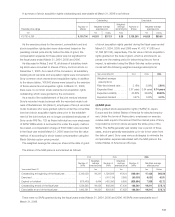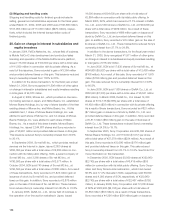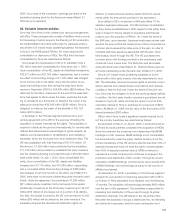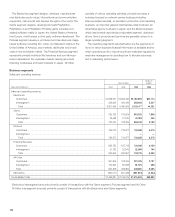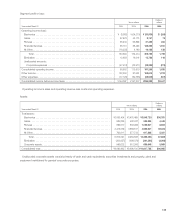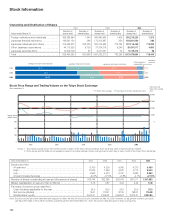Sony 2006 Annual Report Download - page 133
Download and view the complete annual report
Please find page 133 of the 2006 Sony annual report below. You can navigate through the pages in the report by either clicking on the pages listed below, or by using the keyword search tool below to find specific information within the annual report. 131
2005. As a result of the conversion, earnings per share of the
subsidiary tracking stock for the fiscal year ended March 31,
2006 are not presented.
23. Variable interest entities
Sony has, from time to time, entered into various arrangements
with VIEs. These arrangements consist of facilities which provide
for the leasing of certain property, the financing of film production,
the implementation of a stock option plan for Japanese employ-
ees and the U.S.-based music publishing business. As described
in Note 2, the FASB issued FIN No. 46, which requires the
consolidation or disclosure of VIEs. The VIEs that have been
consolidated by Sony are described as follows:
Sony leases the headquarters of its U.S. subsidiary from a
VIE, which has been consolidated by Sony since July 1, 2003.
Upon consolidation of the VIE, assets and liabilities increased by
¥25,277 million and ¥27,035 million, respectively, and a cumula-
tive effect of accounting change of ¥1,729 million was charged
to net income with no tax effect. Sony has the option to pur-
chase the building at any time during the lease term which
expires in December 2008 for ¥29,942 million ($256 million). The
debt held by the VIE is unsecured. At the end of the lease term,
Sony has agreed to either renew the lease, purchase the build-
ing or remarket it to a third party on behalf of the owner. If the
sales price is less than ¥29,942 million ($256 million), Sony is
obligated to make up the lesser of the shortfall or ¥25,128
million ($215 million).
A subsidiary in the Pictures segment entered into a joint
venture agreement with a VIE for the purpose of funding the
acquisition of certain international film rights. The subsidiary is
required to distribute the product internationally, for contractually
defined fees determined as percentages of gross receipts, as
defined, and is responsible for all distribution and marketing
expenses, which are recouped from such distribution fees. The
VIE was capitalized with total financing of ¥47,673 million. Of
this amount, ¥1,292 million was contributed by the subsidiary,
¥11,155 million was provided by unrelated third party investors
and the remaining funding is provided through a ¥35,226 million
bank credit facility. On July 1, 2003, Sony consolidated this
entity. Upon consolidation of the VIE, assets and liabilities
increased by ¥10,179 million and ¥10,586 million, respectively,
and a cumulative effect of accounting change of ¥388 million
was charged to net income with no tax effect. As of March 31,
2006, there were no amounts outstanding under the bank credit
facility. Under the agreement, the subsidiary’s ¥1,292 million
($11 million) equity investment is the last equity to be repaid.
Additionally, it must pay to the third party investors up to ¥2,231
million ($19 million) of any losses out of a portion of its distribu-
tion fees. Any losses incurred by the VIE over and above ¥3,523
million ($30 million) will be shared by the other investors. The
subsidiary acquired the international distribution rights, as
defined, to twelve pictures meeting certain minimum require-
ments within the time period provided in the agreement.
Sony utilized a VIE to implement a SAR plan (Note 17) for
selected Japanese employees. The VIE has been consolidated
by Sony since its establishment. With respect to this entity, there
was no impact to Sony’s results of operations and financial
position upon the adoption of FIN No. 46. Under the terms of
the SAR plan, upon exercise, Japanese employees receive cash
equal to the amount that the market price of Sony Corporation’s
common stock exceeds the strike price of the plan. In order to
minimize cash flow exposure associated with the plan, Sony
held treasury stock through the VIE. The VIE purchased the
common stock with funding provided by the employee’s cash
contribution and a bank loan. The SAR plan was terminated
during the fiscal year ended March 31, 2006 and there were no
amounts outstanding under the bank loan at March 31, 2006.
Sony’s U.S.-based music publishing subsidiary is a joint
venture with a third party investor that was determined to be a
VIE. The subsidiary owns and acquires rights to musical compo-
sitions, exploits and markets these compositions and receives
royalties or fees for their use. Under the terms of the joint ven-
ture, Sony has the obligation to fund any working capital deficits.
In addition, the third party investor receives a guaranteed annual
dividend of up to $7 million and has the option to put its 50%
ownership interest to Sony in exchange for a payment of $200
million. At March 31, 2006, the fair value of the third party’s 50%
interest exceeded $200 million.
VIEs in which Sony holds a significant variable interest but is
not the primary beneficiary are described as follows:
As described in Note 6, on April 8, 2005, a consortium led by
SCA and its equity partners completed the acquisition of MGM.
Sony has reviewed the investment and determined that MGM
Holdings is a VIE. However, MGM Holdings is not consolidated
but accounted for under the equity method as Sony is not the
primary beneficiary of this VIE as Sony absorbs less than 50% of
expected losses and does not have the right to receive greater
than 50% of expected residual returns. MGM continues to
operate as a private company and continues to engage in the
production and distribution of film content. Through its current
ownership of MGM Holdings’ common stock, Sony records 45%
of MGM Holdings’ net income (loss) as equity in net income of
affiliated companies.
On December 30, 2005, a subsidiary in the Pictures segment
entered into a production/co-financing agreement with a VIE to
co-finance 11 films scheduled to be released over the following
15 months. The subsidiary will receive approximately $400 million
over the term of the agreement. The subsidiary is responsible for
marketing and distribution of the product through its global
distribution channels. The VIE shares in the net profits of the
films after the subsidiary recoups a distribution fee, its marketing
and distribution expenses, and third party participation and


